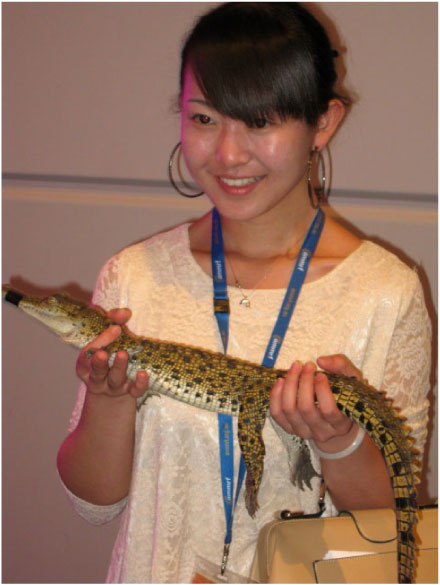Polymer Science Goes to the Top: The 34th Australasian Polymer Symposium, Darwin
Kevin JackCentre for Microscopy and Microanalysis, The University of Queensland, St Lucia, Qld 4072, Australia. Email: k.jack@uq.edu.au

Kevin Jack completed a B.Sc. (Hons) in chemistry at Canterbury University, New Zealand, and a Ph.D. in polymer chemistry at the University of Queensland in 1995 with Andrew Whittaker and David Doddrell. He undertook post-doctoral positions at Queen's University, Ontario, Canada, and then at Bristol University, UK (with Terry Cosgrove) and later worked as a research scientist at the Bristol Colloid Centre. In 2004, he returned to the University of Queensland, and is currently Senior Research Fellow and Scientific Manager of the X-ray analysis facility at the Centre for Microscopy and Microanalysis. His current research interests are focused on the understanding of structure-property-performance relationships in a range of nanostructured materials and also on the advanced characterisation of polymers, colloids, and composites by X-ray and neutron methods. |
Australian Journal of Chemistry 67(4) 535-537 https://doi.org/10.1071/CH14163
Published: 7 April 2014
The Australasian polymer symposium (APS) has a long established tradition of bringing together the polymer science and engineering communities of Australasia and many of our esteemed colleagues from around the world. The 34th APS was no exception to this, with a program that covered a broad range of themes and which incorporated the latest advances in polymer synthesis, characterisation, processing, and modelling as well as innovative applications of polymeric materials in, e.g., health and medicine, energy, sustainability, and future devices. However, 2013 saw some changes to the APS format. Most noticeable was the fact that the meeting was held in the Northern Territory for the first time and the local environment and climate (see Fig. 1) were well received by our international and domestic delegates alike, many of whom had not ventured to the tropical north of Australia before. Additionally, 34APS saw the inclusion of a symposium theme dedicated to Polymers in Industry and Translational Research, which included keynote lectures form Leo Hyde (Dupont, Australia), Derek Irvine (University of Nottingham) and Chris Such (Dulux, Australia; recipient of the Bruce Guise Industrial Polymer Technology Award).

|
The scientific program started on the Sunday evening with inspiring plenaries from Cameron Alexander (University of Nottingham) and Anna Balazs (University of Pittsburgh) and was closely followed by a visit from some local fauna at the welcome reception (see Fig. 2). Each morning saw further inspiring plenaries from Kristi Anseth (University of Colorado), Maria Forsyth (Deakin University) and Axel Müller (Johannes Gutenberg-Universität), with Mitsuo Sawamoto (Kyoto University) providing the final plenary and scientific contribution to the symposium. In line with the trends of the previous meetings, the contributors at 34APS represented a vast range of disciplines including chemistry, biology, physics, nanotechnology, applied mathematics, engineering, (bio)materials science, colloid and interfacial science, R&D and commercial services from a diverse range of backgrounds, e.g. researchers, industry leaders and experts in intellectual property; once again emphasising how the bridging of these disciplines has become essential for the advancement of contemporary polymer science. As a reflection of this, each of the symposium themes was led by keynote presentations which covered a range of polymer topics: Luc Averous (Université de Strasbourg), Christopher Bowman (University of Colorado), Paul Burn (University of Queensland), Neil Cameron (Durham University), Paul Dastoor (University of Newcastle), Cecile Dreiss (Kings College, London), Bob Gilbert[1] (University of Queensland), Leo Hyde (DuPont), Derek Irvine (University of Nottingham), Masami Kamigaito[2] (Nagoya University), David Lewis (Flinders University), Zi-Chen Li[3] (Peking University), Jean-Francois Lutz (Université de Strasbourg), Shigeru Okamoto (Nagoya Institute of Technology), Sebastien Perrier (University of Sydney; recipient of a Polymer Citation), Theresa Reineke (University of Minnesota), Holger Schönherr[4] (Universität Siegen), Brent Sumerlin (Southern Methodist University), Erica Wanless (University of Newcastle), and Yanlei Yu[5] (Fudan University).

|
The heart of any scientific meeting, arguably, resides in the contributions from the conference delegates and over three-and-a-half days the 250 delegates at 34APS were treated to over 200 oral and 60 poster presentations. Included in these presentations were those from the invited Emerging Talent speakers James Blinco (Queensland University of Technology), Cyrille Boyer (University of New South Wales), David Huang[6] (University of Adelaide), Jianyong Jin[7] (University of Auckland), and Georgina Such (University of Melbourne); the Treloar Prize winners for the best oral (Shu Jie Lam,[8] University of Melbourne) and poster (Steven Harris Wibowo,[9] University of Melbourne) presentations; and a RAFT (pun intended) of presentations from early career researchers and students from Australasia and international institutes.
It was exciting to witness how the past (and ongoing) developments in controlled polymerisation techniques and the synthesis of well defined polymers at the molecular level are leading to burgeoning fields of research in the advanced physical characterisation and understanding of polymer nanostructures and polymeric materials, as well as the development of an array of applications for these polymers that are already enhancing our societies. As a result of the ongoing collaborative efforts of the Australian Journal of Chemistry and the Polymer Division of the Royal Australian Chemical Institute, it is with great pleasure to me that examples of these contributions are able to be disseminated through this special issue.
Perhaps more opus than operetta, Gilbert and Sullivan[1] present their developments in size exclusion chromatography for studying the molecular organisation in a natural bioloymer, glycogen. The methodology provides insight into the formation and degradation processes of glycogen primary particles and aggregates in these polymers. Importantly, these findings will have implications in the understanding and control of Type 2 diabetes in humans. Tücking et al.[4] have also studied polymeric nanostructures using a range of advanced characterisation techniques, including fluorescence lifetime measurements – which they develop to elucidate the mechanism of enzymatic degradation of polymer vesicles – that have potential applications as biosensors.
As noted above, the development and application of synthetic polymerisation methods continue to generate much interest in the polymer science community. For example, Deng et al.[3] report the details of a recently developed novel synthetic method for fabricating graft copolymers comprised of a polyamide backbone and polyvinyl or polyester side chains. This methodology produces polymer structures with labile side chains, which provides advantages in the characterisation and applications of the materials. In addition, the work of Mizutani et al.[2] demonstrates a new metal-catalysed chain- and step-growth polymerisation strategy for synthesising well-defined copolymer structures with the scope of widening the type of copolymer systems and architectures that can be achieved synthetically. The development of synthetic methodologies for the fabrication of polymer nanostructures with potential applications as carrier platforms for siRNA is a topic presented by Lam et al.[8] In keeping with the theme of the multi-disciplined nature of contemporary polymer science, this year’s winner of one of the prestigious Treloar prizes details the synthetic methods and knowledge developed along with some advanced nano-scale characterisation and studies of the cytotoxicity of the polymers. New synthetic pathways for the preparation of novel biopolymer architectures are also reported by Wilcox et al.[7] In this work, the potential for these materials as biosensors is also demonstrated.
The growing importance of polymers in providing solutions for the increasing energy requirements of the world is highlighted by the contribution from Huang,[6] who uses molecular dynamics simulations to probe the nano-scale structure and electronic properties of conjugated polymers and to compare these with experimental observations.
Thin polymeric films or coatings are the topic of contributions from Jiang et al.[5] and Wibowo et al.,[9] although the polymers used, methods of fabrication, and applications are distinct. In the first of these works, a demonstration of photo-deformable polymeric films is provided, along with an understanding of key structure–function relationships in these types of materials.[5] In contrast, the latter work (which was also awarded a Treloar Prize) looks at the grafting of peptides onto different substrates, including fabrics, with the effect of modifying a range of properties, e.g. the hydrophobicity or the biological interactions.[9]
Once again, I would like to thank all of the contributors to both this special issue and 34APS. It is, after all, these works that made the meeting such a success.
References
[1] R. G. Gilbert, M. A. Sullivan, Aust. J. Chem. 2014, 67, 538.| Crossref | GoogleScholarGoogle Scholar |
[2] M. Mizutani, K. Satoh, M. Kamigaito, Aust. J. Chem. 2014, 67, 544.
| Crossref | GoogleScholarGoogle Scholar |
[3] X.-X. Deng, Y. Cui, Y.-Z. Wang, F.-S. Du, Z.-C. Li, Aust. J. Chem. 2014, 67, 555.
| Crossref | GoogleScholarGoogle Scholar |
[4] K.-S. Tücking, S. Handschuh-Wang, H. Schönherr, Aust. J. Chem. 2014, 67, 578.
| Crossref | GoogleScholarGoogle Scholar |
[5] Z. Jiang, J.-a. Lv, F. Chen, J. Wei, Y. Yu, Aust. J. Chem. 2014, 67, 570.
| Crossref | GoogleScholarGoogle Scholar |
[6] D. M. Huang, Aust. J. Chem. 2014, 67, 585.
| Crossref | GoogleScholarGoogle Scholar |
[7] C. Wilcox, J. Jin, H. Charville, S. Swift, T. To, P. A. Kilmartin, C. W. Evans, R. Cooney, M. Brimble, Aust. J. Chem. 2014, 67, 562.
| Crossref | GoogleScholarGoogle Scholar |
[8] S. H. Wibowo, A. Sulistio, E. H. H. Wong, A. Blencowe, G. G. Qiao, Aust. J. Chem. 2014, 67, 598.
| Crossref | GoogleScholarGoogle Scholar |
[9] S. J. Lam, A. Sulistio, K. Ladewig, E. H. H. Wong, A. Blencowe, G. G. Qiao, Aust. J. Chem. 2014, 67, 592.
| Crossref | GoogleScholarGoogle Scholar |


